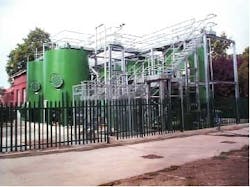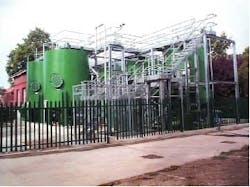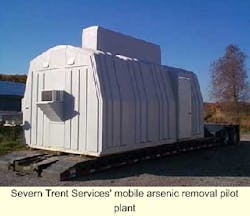Company Offers New Arsenic Removal Technology
Recent changes to the allowable arsenic concentration in European drinking water supplies are catching the attention of American environmental regulators and suppliers of treatment technologies for removal of this naturally occurring element. In Europe, regulators have reduced the longstanding limit for arsenic from 50 to 10 mg/l. A similar standard and requirement is being considered by the EPA in the U.S.
Arsenic is a known human carcinogen and exposure to high levels in drinking water and foods poses serious health effects. As a carcinogen, it affects the skin, bladder, lungs and prostate. Non-cancer risks include skin pigmentation and keratosis, and gastrointestinal, cardiovascular and hormonal effects. Arsenic has been reported to affect the vascular system in humans and has been associated with the development of diabetes.
Severn Trent Services, a U.S.-based provider of water and wastewater treatment solutions, has been working with its UK affiliate, Severn Trent Water, since 1994, evaluating technologies for arsenic removal. Some of the options researched were ion exchange, RO membrane filtration, chemical coagulation, and adsorbent medium.
Severn Trent, in conjunction with a large chemical supplier, has developed a granular ferric hydroxide (GFH) absorbent media that is extremely efficient in removing arsenic from contaminated groundwaters to well below the proposed limit of 10 mg/l. The GFH does this by complexing arsenic present in the water with itself in an irreversible reaction. This new process, SORB 33, concentrates the media in specially designed adsorbers.
The first full-scale SORB 33 plant has been installed by Severn Trent at a groundwater site near Nottingham, England, where groundwater, prior to installation, was contaminated with arsenic at a concentration of greater than 20 mg/l. The treatment process successfully removes this arsenic contamination to less than 5 mg/l. The plant supplies 5.3 MGD of water to the English community. The SORB 33 system was built as a retrofit to the existing water treatment plant at a cost of $2 million.
The GFH media has an expected bed life of over 200,000 bed volumes, equivalent to over 12 months for most ground waters. For the average American family, arsenic treatment costs would equate to approximately $25 per year. The spent GFH media can be safely disposed of in a sanitary landfill. Tests have shown that the absorbed arsenic does not leach out of the waste absorbent.
An additional 16 SORB 33 systems are under construction and will be commissioned in a phased program in Severn Trent Water plants in the UK over the next 12 months.
Closer to home, the process is successfully completing a trial at a contaminated well site in New Mexico where the pre-treated water's arsenic concentration is 50 mg/l. The larger of 2 GFH columns has a feed rate of 1.3 gpm. A mobile validation plant is available for additional trials on arsenic-contaminated well sites throughout the U.S.


